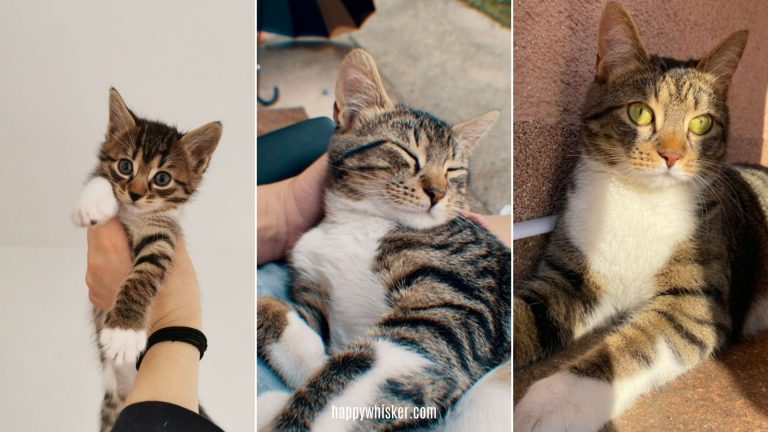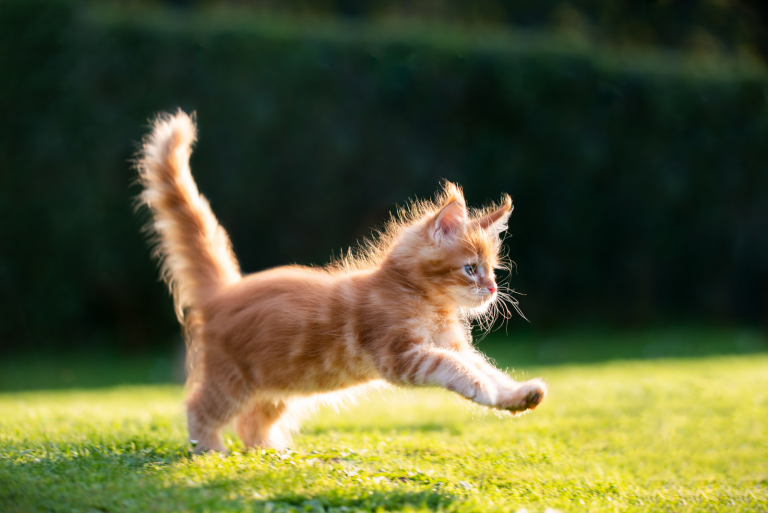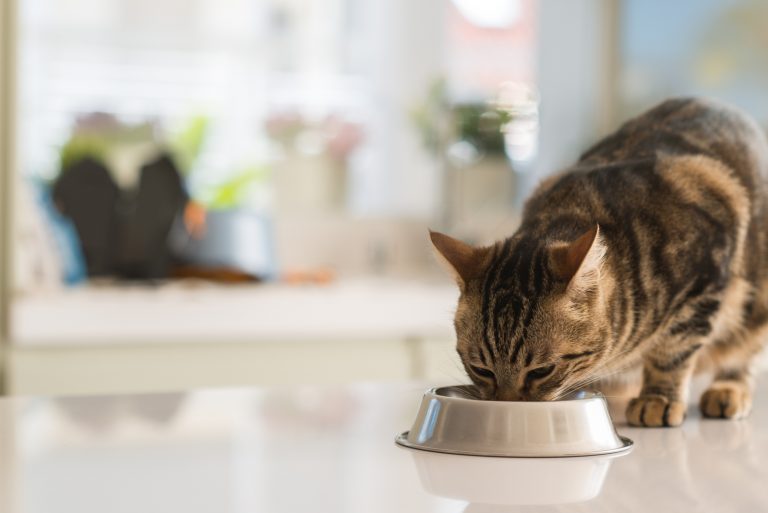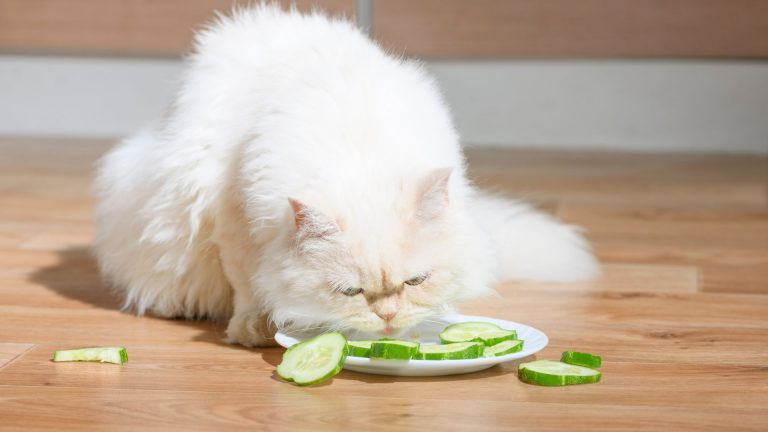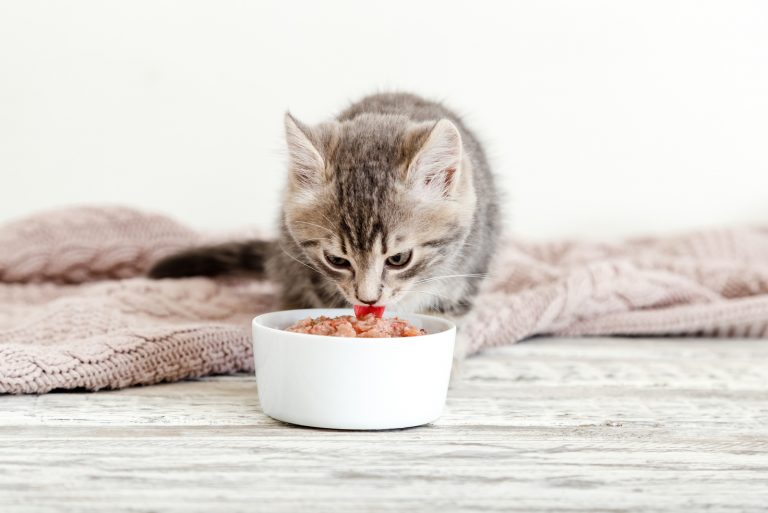How Much Should A 10 Week Old Kitten Eat? An Owner’s Guide
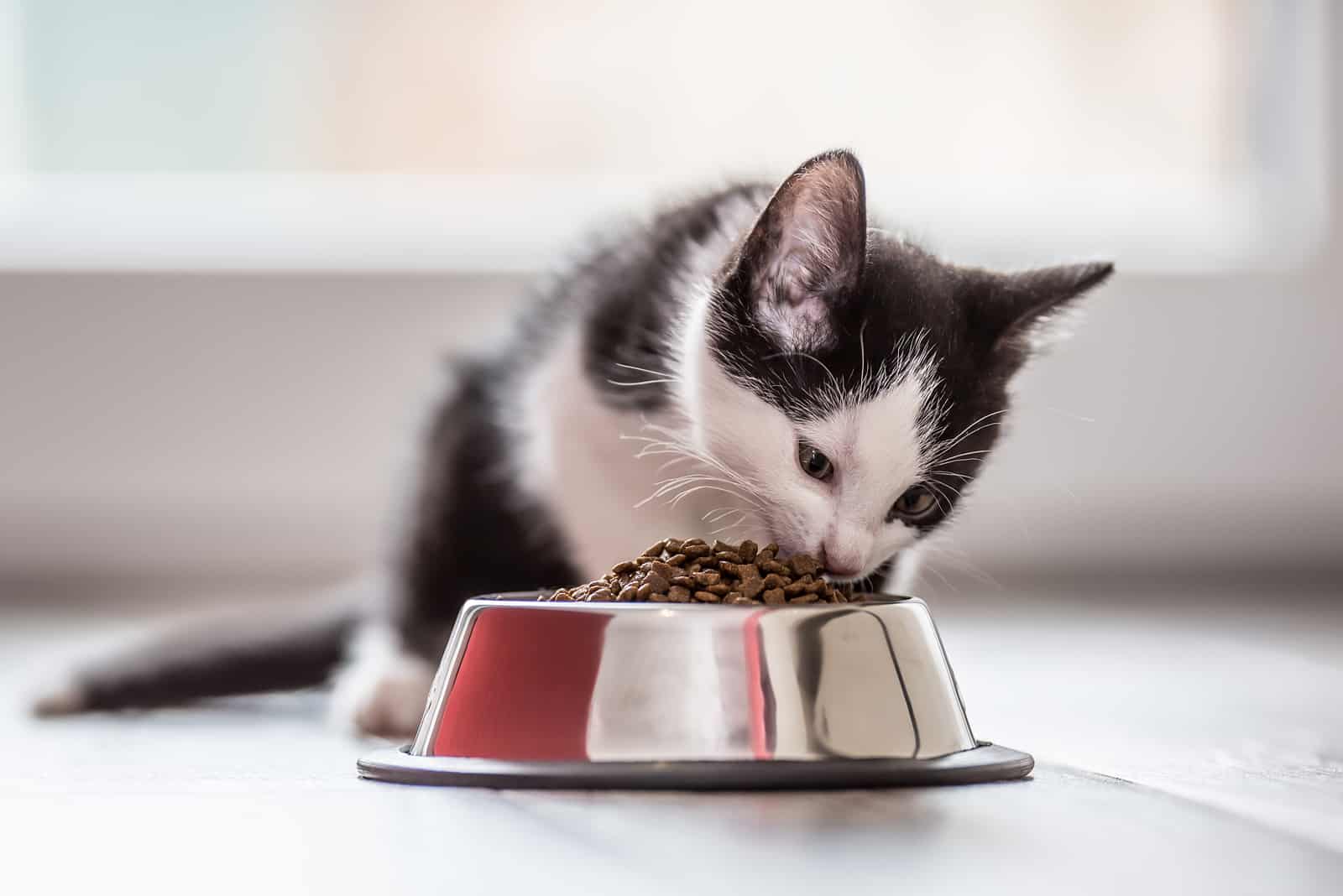
If you’re reading this, you must be the proud owner of a soon-to-be 10 week old kitten. How are you liking it so far? I am sure you’re enjoying the time you’re spending with your tiny friend, but your kitten is growing up so fast!
Now that your pet is past the weaning stage you’re the one who has to provide proper meals. So I’m sure you’re wondering Well… how much should a 10 week old kitten eat?
A 10 week old kitten should eat around four to five times a day. Daily caloric intake should be anywhere from 220 to 320 calories. Both wet and dry food is suitable for a cat of this age.
In order for your kitty to become a big, strong adult cat, it is important that they receive the appropriate kitten care. Of course, that involves giving your furry friend the right type of food. But, which food is recommended? How much of it should they eat, and how often?
Continue reading to find out everything you need to know about how to feed your 10 week old kitten!
How Much Should A 10 Week Old Kitten Eat?
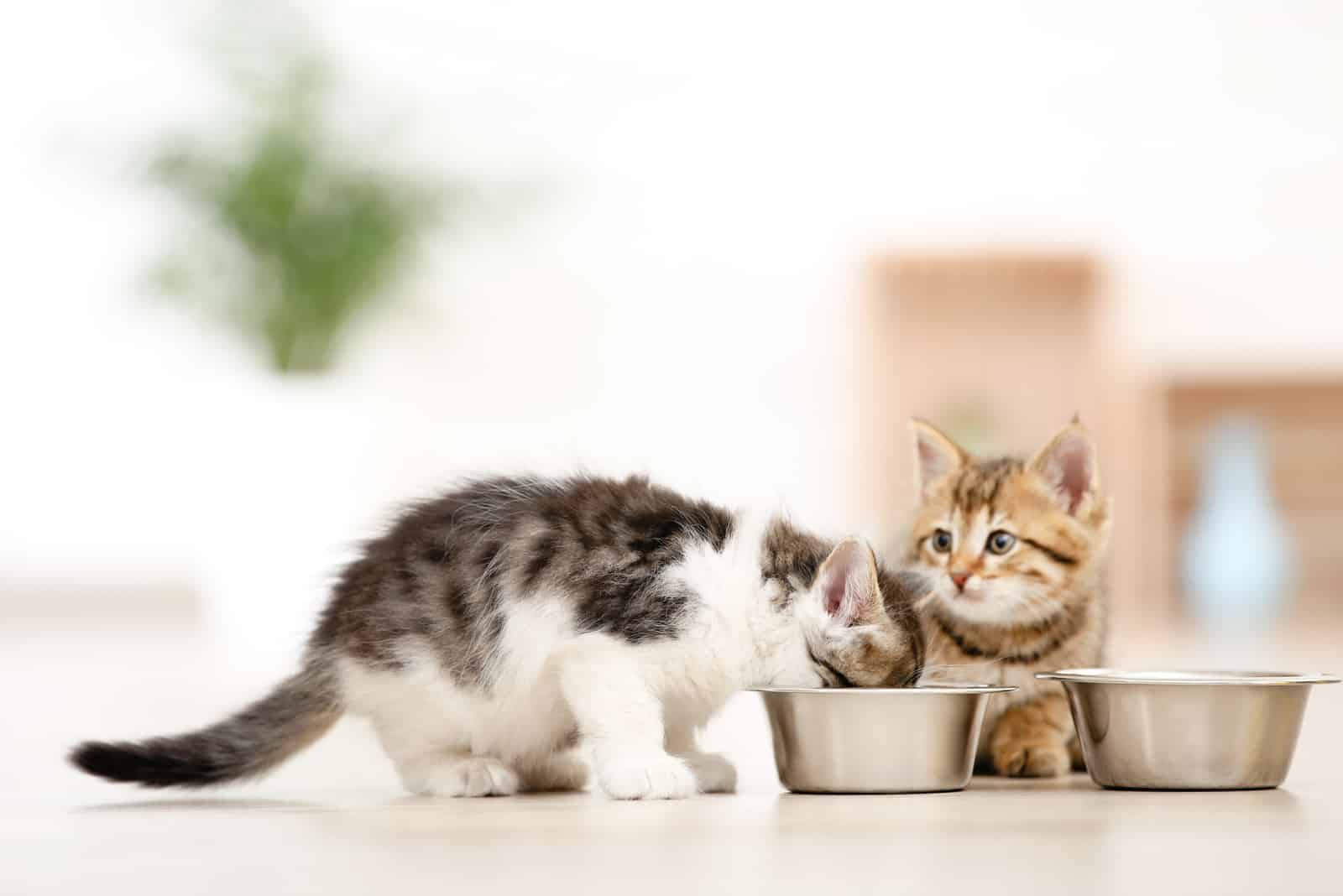
There aren’t any hard-set rules that state exactly how much your kitten needs to eat.
A kitten of this age will usually weigh around 2.5 lbs. For this weight, it’s recommended that a growing kitten should have approximately 240 calories per day.
Based on this, you can deduce how much your kitten should eat.
🐾 Does your kitten weigh a bit less or a bit more?
For example, if your kitten weighs more, give them more calories than recommended for the 2.5 lbs kitten.
🐾 Is your kitten extra-energetic?
If your kitten is restless and wastes no time on naps, they will also need extra calories than recommended for their weight.
Does Cat Breed Matter?
Kitten needs might differ based on the breed.
For example, a Maine Coon kitten at 10 weeks of age will be a bit bigger than a kitten of a typically smaller breed. Kittens of larger breeds will need a little bit more food (but not too much more!) than an average kitten.
Cat breed does matter. Kittens of different breeds can require a slightly different daily caloric intake.
What Is The Best Food For A 10 Week Old Kitten?
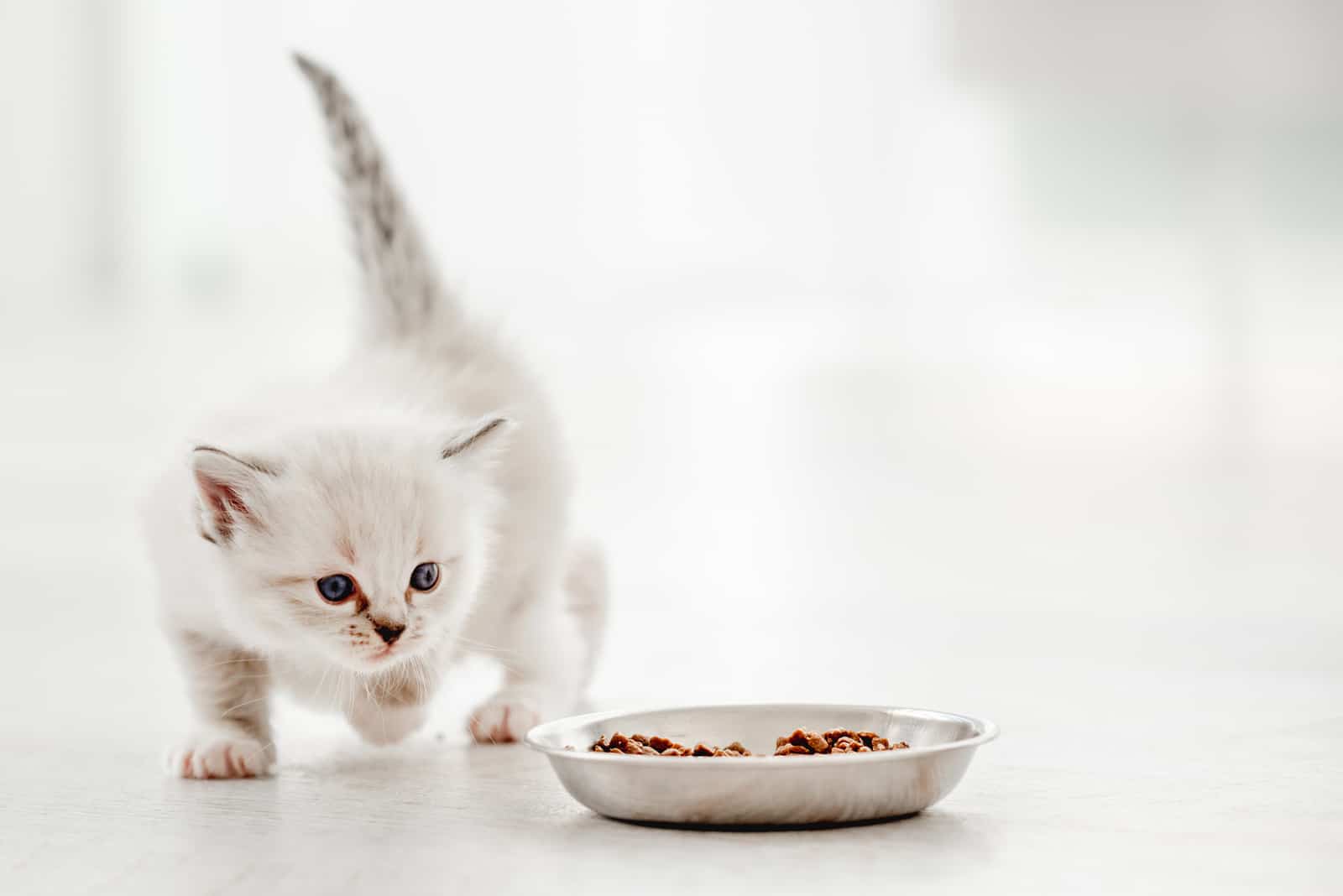
It is recommended that you introduce wet food to kittens at the age of three weeks old. Dry food is recommended for kittens two weeks after introducing wet food, meaning 5 week old kittens can be introduced to kibbles.
10 month old kittens should eat both wet food and dry food. It’s very important for the kitten food to be high quality.
Remember, all nutritional needs are now provided by the owner, and not by the kitten’s mother.
Let’s go over both types of cat food separately, and find out which dry and wet food combination works best for 10 week old kittens!
Suggested: What’s The Best Food For Kittens In 2023?
Wet Food
Wet food is an important part of a kitten’s diet because it provides water to the kitten. Young kittens (and most cats for that matter) are not the biggest fans of drinking water, so moisture from canned food actually helps hydrate your kitten.
Apart from water, canned food is an amazing source of proteins and fats (an even better source than dry food!)
Canned food tends to be more expensive than dry food, but it’s what your kitten needs.
How Much Wet Food Should My 10 Week Old Kitten Eat In A Day?
It all depends on how you feed your cat. Does your cat only eat wet kitten food that day? Or does your cat also eat dry food that day?
There is no rule regarding the actual recommended weight of wet kitten food. All that matters is the caloric intake.
If you plan on giving your cat just wet food that day, give them as much as it takes to satisfy the caloric needs of your 10 week old kitten. This may vary depending on the brand of wet food you have chosen.
Try to combine some dry food with your kitten’s wet food! A kitten should eat a mixture of both wet and dry food, so make sure to incorporate kibbles as well.
Related: How Much Wet Food To Feed A Cat Per Day? Let’s Find Out
Dry Food
Dry food is a convenient, calorie-dense cat food option that cats love, and owners love how convenient it is.
Make sure you’re giving your cat high-quality dry food made for kittens. Manufacturers know perfectly well what a growing kitten needs, so a good quality food will have all the nutrients your kitty needs.
10 week old kittens should have no problems chewing their kibbles. However, if you observe your kitten experiencing some difficulties, you can add a little bit of warm water in order to make the food softer.
How Much Dry Food Should I Feed My 10 Week Old Kitten?
It’s usually recommended that you give your kitten 1/3 or 1/2 a cup of kibbles per meal. If your kitten is a larger cat breed, feel free to increase the portion slightly.
Also, if you feel your kitten is a bit thin, you can give them more kibbles in order to help them gain weight. Kibbles are calorie-dense, so they’re great for weight gain.
Extra Tip: If you want to learn more about healthy weight gain, check out Happy Whisker’s article on homemade cat food that supports weight gain.
Can You Free Feed A 10 Week Old Kitten?
Yes, you can.
Many cat owners introduce free feeding at this time. Free feeding is a feeding technique where you simply place a filled food bowl out in the open, so your cat can eat whenever they want to.
The only thing about free feeding is that you need to keep a close eye on your cat’s body weight. Free feeding gives your cat the freedom to eat whenever and how ever much they like, so just make sure your cat does not gain any unhealthy weight.
One Thing To Keep In Mind
Make sure your kitten eats both wet and dry food. Keep in mind that the same mass of dry food and wet food don’t have the same number of calories.
Dry food contains more calories than the same quantity of wet food. For example, you can give your cat 60 grams of dry food and 220 grams of wet food as their daily food intake.
Because of this, give your cat a bit more wet food compared to dry food, so the two types of food are balanced calorie-wise.
How Often Should 10-Week Old Kittens Eat?
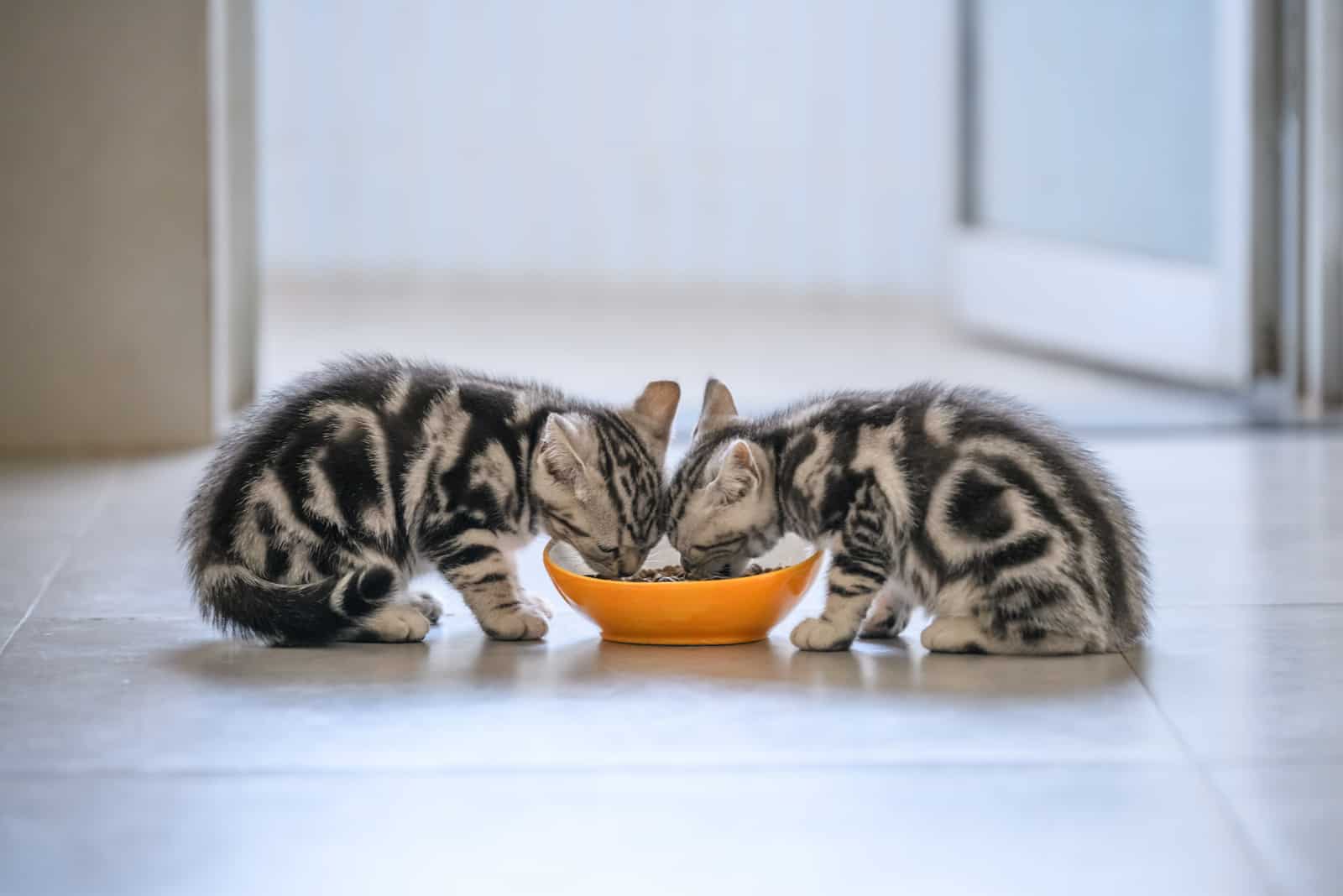
Now that you know the daily caloric intake for your kitty, you might be wondering How many times should a kitten eat in a day?
Kittens are fed more frequently than adult cats, so expect to have to feed your kitty more often.
Some kittens like to eat 4 times a day, while others can eat 5 or 6 times a day. Most experts say that 4 times a day is optimal.
It really depends on your cat. If your kitty is a bit on the lazier side, it will eat 4 times a day, while very playful kittens tend to eat 5 or 6 times a day.
Does Feeding Schedule Matter?
It is highly recommended to keep a regular feeding schedule for your kitty. This is not a recommendation for kittens only – it is advised that adult cats have a schedule too!
What’s The Benefit Of Having A Regular Feeding Schedule For Your Kitten?
Well, there are two key benefits of having regular meal times:
🐾 Spreading your cat’s caloric intake evenly.
If you spread out your cat’s meals evenly during the day, there is less risk of your kitty being overfed in the morning, and then hungry in the afternoon, for example.
This way, your cat will be happy and energetic throughout the entire day. This also helps your cat form a habit of having a regular feeding schedule that will continue into adulthood.
🐾 Approximately knowing when your kitty‘s going to use the litter box.
Regular feeding means regular bathroom habits! This might be important for cat owners that want to keep track of their cat’s litter box habits.
Can You Overfeed A 10 Week Old Kitten?
Now that you know how much should a 10 week old kitten eat, you might be wondering if there’s a risk of you giving them a little bit more food than you should.
The truth is, you cannot really overfeed a 10 week old kitten. All food you give your kitten will efficiently be used to make your kitten bigger and stronger.
At this time, they’re growing and developing rapidly, so they need all the energy they can get!
Kittens aren’t prone to obesity, so you don’t have to worry if you’ve given your kitten a cup of kibbles over the ‘recommended’ amount. They’re so energetic that they will spend those calories in no time.
Adult cats are at risk of gaining weight due to frequent, calorie-dense meals, but not kittens. You will need to pay more attention to overfeeding when your kitten gets older.
Do Kittens Need Milk At 10 Weeks?
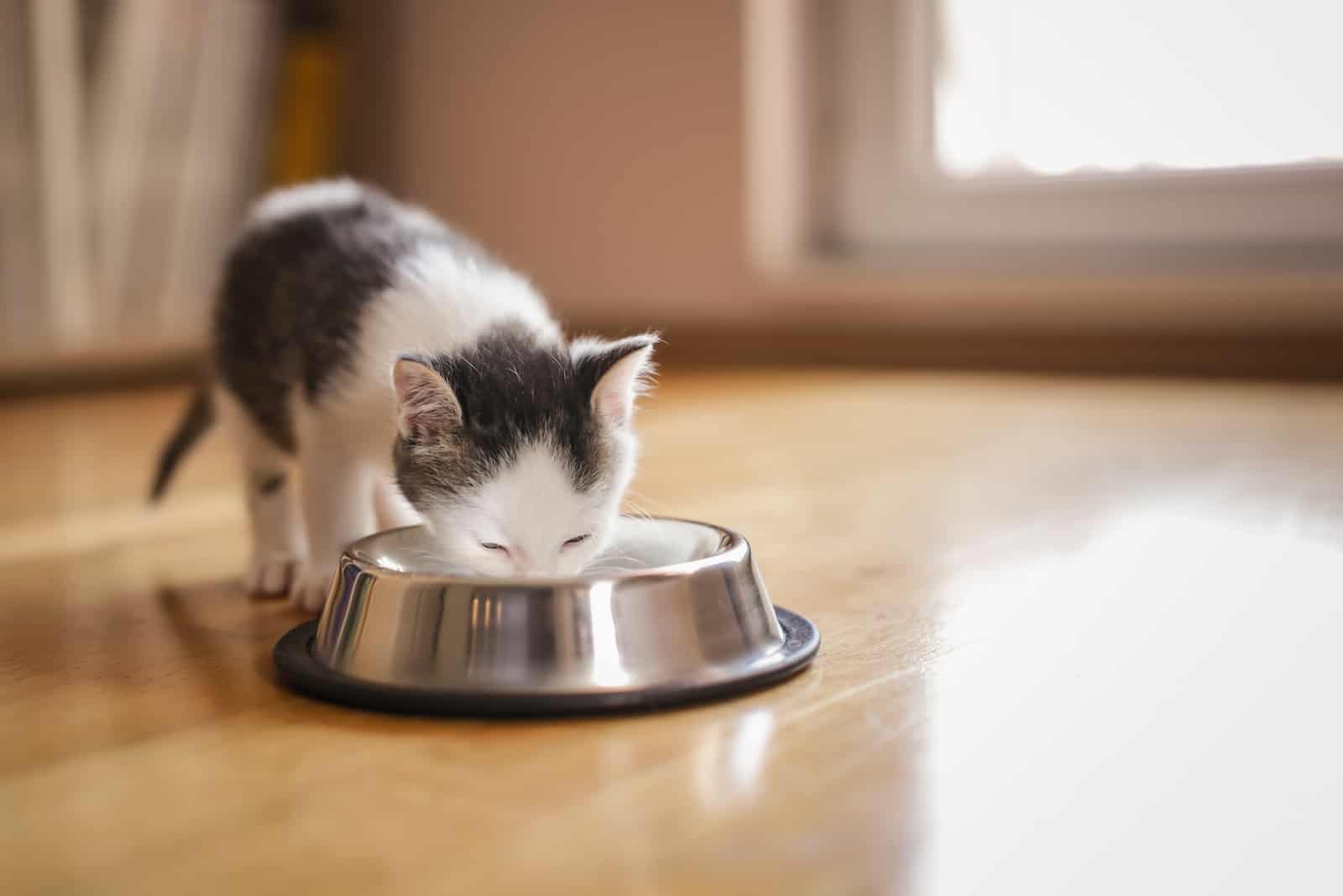
Newborn kittens are completely dependent on their mother’s milk. But at the age of 6-8 weeks, kittens will be weaning. That means their mother cat’s milk is no longer a necessity.
Kittens do not need their mother’s milk at 10 weeks old and your kitten was probably already weaned off its mother from eight weeks of age.
A kitten does not need any kind of milk replacement, so do not give your kitty cow’s milk or any other kind of milk!
A kitten’s diet at this stage should be completely milk-free. Kittens and cats cannot handle other kinds of milk (besides their mother’s). This is because they cannot digest lactose and it gives them tummy issues.
Kitten Feeding Chart By Age
Let’s go over some of the basics a kitten’s diet develops as they grow into adult cats. Read on to find out what you can expect of your kitten’s diet after they turn 10 weeks old.
Let’s get to it!
Key Points In Your Kitten’s Diet
0 – 4 Weeks
At this stage, kittens are completely dependent on their mother’s milk or kitten milk replacer. You should never give a newborn kitten any kind of kitten food!
If a mother cat’s milk is unavailable for whatever reason, the kitten will need to be bottle-fed with a kitten milk replacer. This contains all the nutrients a kitten of this age might need. Never give a kitten any other type of milk. Kitten formulas are available in both liquid and powder form.
It’s recommended to bottle feed kittens (that can’t be nursed by their mothers) about 7 times a day.
4 – 8 Weeks
Towards the kitten’s third week, the weaning process begins. That’s when a kitten starts its transition from milk to solid food. Both dry and wet kitten food can be given to kittens of this age.
However, it’s recommended that the dry and wet food are designed specifically for kittens, and not adult cats. Kittens of this age can have meals anywhere from 3 to 6 times a day, depending on the cat and their owner.
2 – 6 Months
The feeding schedule here should be 3 to 4 times a day and your kitty should have both wet and dry food. Of course, as your cat is getting bigger, you should be giving them a slightly larger amount of food.
Many cat owners introduce free feeding to their cats at this stage, so you can too and see if it works for your cat. Free feeding is only done with dry, solid food, because wet food tends to spoil when sitting out for a longer period of time.
To learn more, I suggest reading Happy Whisker’s article on the size and growth changes of 4-month-old kittens.
6 – 10 Months
A cat of this age usually eats 2 to 3 times a day.
At this stage, your kitten and you will most likely develop a regular feeding routine. As you’ve already introduced your kitten to different types of food or numbers of feeding sessions, you’ve probably learned what works best for you and your pet.
It’s important to provide your cat with different types of food, so they don’t turn out to be very picky eaters. Make sure you keep a good balance between wet and dry kitten food.
10 Months – 1 Year
At this stage, you can start the transition from kitten food to adult cat food. Also, from now on you need to start paying attention to your kitty’s possible weight gain.
Now that your pet is no longer a playful kitten that needs tons of energy derived from food, you need to keep an eye on how much food your cat is eating.
Naturally, a cat’s metabolism slows down with age, so weight gain might become an issue at this stage. But don’t worry – just make sure your cat is eating the right food in the right amounts, and having plenty of physical exercise.
Kitten Feeding Chart
[table id=88 /]
Please keep in mind that the average weight is just that – an average. Your kitten does not have to have that exact weight. It can be a little bit above or below the average weight – and that’s perfectly fine!
A Few Extra Tips For Your 10 Week Old Kitten
Apart from finding out how much should a 10 week old kitten eat, here are a couple of reminders of your kitten’s fabulous 10th week of age and what you as an owner should have done by now.
1. Vaccination
A kitten’s first vaccination is due at 6-8 weeks of age. This is the FVRCP vaccination that protects your cat from several dangerous viruses such as feline herpes virus, calicivirus, and feline panleukopenia.
There should be a gap of 3-4 weeks before the 1st and 2nd vaccination.
If you vaccinated your kitty at 7 weeks of age, now you need to re-vaccinate. If you vaccinated your kitty at 8 weeks of age, just know you have another vaccination coming up!
Vaccinations are very important, so make sure you keep track of every important vaccination date!
2. Allow Freedom (But Not Too Much!)
Kittens are known to be very playful and full of energy. This is completely normal and healthy for the kitten. Kittens need to explore their environment and that should be encouraged.
Just because they’re little explorers doesn’t mean they should get to do everything they want! Bad behavior should not be encouraged, but it should not be punished either!
The best way to train your kitten is to use positive reinforcement, meaning you should reward your cat’s good behavior, with treats for example.
Disciplining your kitty early on prevents them from becoming a naughty adult cat.
3. Socialization
Your kitty’s social skills should be pretty high at this age. That means your kitten is not afraid to approach people and other pets and explore what is going on around them.
It’s important to socialize a kitty so they’re not frightened by human contact or contact with other pets. That can be a big issue as the kitten grows up.
4. Litter Training
Litter training should start as soon as the kitten starts weaning. That means a litter box should be introduced to the cat at 4 weeks of age. By the time your cat is 10 weeks of age, they should have already mastered using the litter-box.
Some kitties take their time and may not be litter-trained at 10 weeks old. But don’t worry – just have patience and I’m sure your furry friend will learn to use a litter box soon!
Final Thoughts
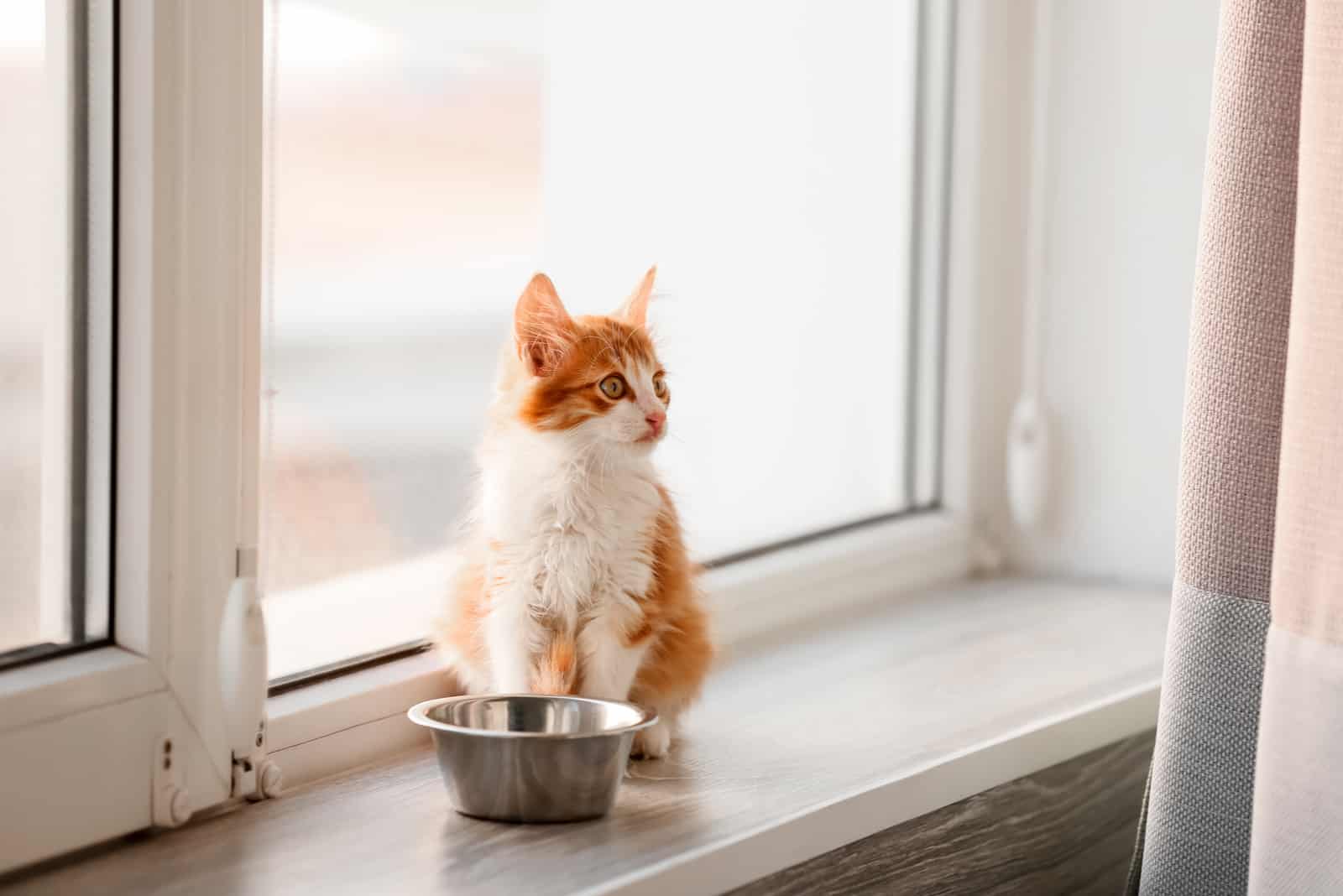
Kitten care is not an easy task! You need to make sure your kitten is growing well, eating healthily, and that everything is as it should be.
One thing every cat owner has a daily responsibility for is the cat’s meals. If your kitten has reached two months of age and is approaching its 10th week of age – you might be wondering How much should a 10 week old kitten eat?
Healthy kittens should eat around 4 times a day, and have a daily caloric intake of anywhere from 220 – 320 calories.
Of course, this is not a rule! It is the recommended guideline, but some kittens might eat a bit more or less than this.
Also, kittens that are a larger breed or who tend to be extra-playful and energetic will need more calories than some kittens that are smaller or prefer sleeping and relaxing more.
The right food for kittens will be a mixture of both canned food and dry food, so make sure to provide your kitten with both types of cat food.
Apart from a proper diet, make sure to pay attention to your cat’s litter box habits, socialization, behavior and of course, their vaccination schedule!
Now you know how much a 10 month old kitten should eat, you can confidently feed your kitten and any new kittens you might get in the future!
Related Articles:
Can Kittens Drink Water? What’s Best For Them?
How Long Can Kittens Go Without Food? Everything You Need To Know

